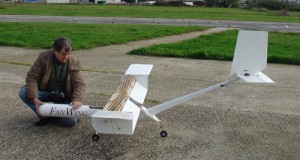Fan Wing UAV

The FanWing experimental aircraft opens up a new area of aerodynamics Designs to establish a means of integral lift and thrust using a horizontal-axis wing rotor are recorded back as far as the late 19th century. Some of the experiments started to take off but did not sustain flight. The FanWing blown-wing solution offers both basic proof of concept and a steady trajectory of improved and controlled flight performance.
Source: Prototype UAV Airframes
The idea The aircraft has a cross-flow fan along the span of each wing. The fan pulls the air in at the front and then expels it over the wing’s trailing edge. In transferring the work of the engine to the rotor, which spans the whole wing, the FanWing accelerates a large volume of air and achieves unusually high lift-efficiency.
Proof of concept The FanWing showed proof of concept in the form of actual flights before theoretical validation, academic research or explanation. The FanWing is an invention by trial and error and though certainly employing a methodology with good precedent in the history of innovation it is in no way within the normal paradigm of academic and conventional aircraft development. There is nevertheless a steady accumulation of tests and supporting documentation.
Wind tunnel tests First wind-tunnel tests were conducted in 1998 by Pat Peebles at the University of Rome. Several universities in various countries have carried out experiments since then independently and sometimes with input from Pat Peebles, notably two wind-tunnel projects for student dissertations requested and supervised by Professor JMR Graham at Imperial College, London, using prototype wings loaned by the FanWing Company. Limited wind-tunnel tests were also completed in the company workshop.
In 2002 a UK Government SMART Award and private investment in the FanWing company funded a series of wind-tunnel tests, providing a basis for construction of a new prototype. The company series of tests was completed at Imperial College with Klaus Kogler assisting FanWing inventor Pat Peebles and with data consultation by Professor J M R Graham.
Efficiency Documented efficiencies for the first prototypes were found to be in the order of 20 grams of lift per Watt of shaft power, indicating an initial lift of 1 –1 ½ tons of weight in the air with 100 hp. Initially, wind-tunnel optimisation at Imperial College (in the company’s 2002 series of tests) indicated 29 g/W. Most recent modifications in wing geometry now indicate in limited linear flight tests (June 2009) an unexpected increase in efficiency up to 35 g/W translating to 26 kg/hp or 2.6 tons for 100 hp. At this initial stage of development, results are based solely on onboard power measurement.
Tests to date have been completed on small wings with low wing-loading.
Speed Flight speeds have ranged from 3m/sec for the smallest model to 17 m/sec for the largest model. Eventual maximum speed remains open to speculation. The prognosis is good: present results are based on minimum experimental resources with eficiencies and speeds nevertheless continually improving.
The proposed CargoLift UAV design concept weighing 5,500 kg (12,000 lbs) will have an estimated flight speed of 36 m/sec (70 kt) at sea level. At higher altitudes the speed will increase doubling at 5,500 m. while maintaining the same flight efficiency.
The FanWing will not have the same altitude speed problems as a helicopter, which is limited in speed by both the advancing and the retreating blade.

Leave a Reply
Want to join the discussion?Feel free to contribute!